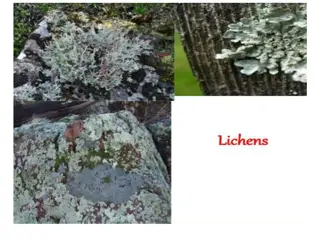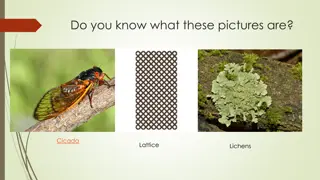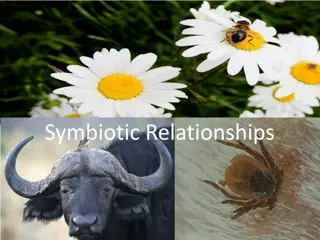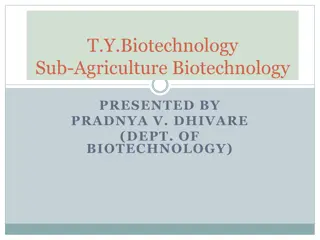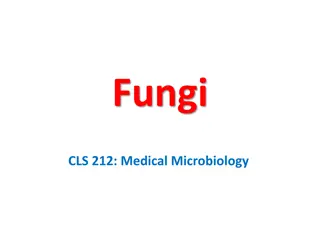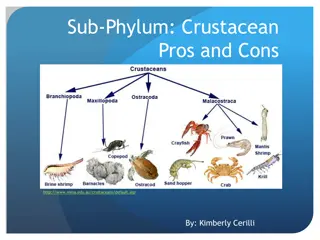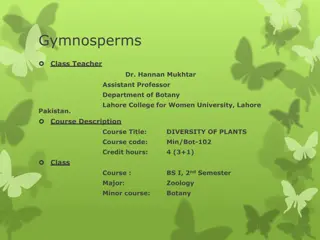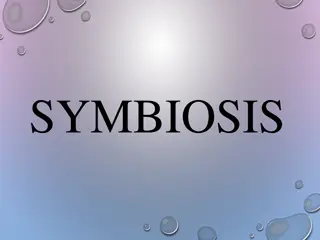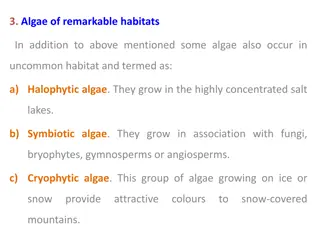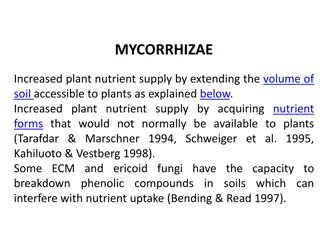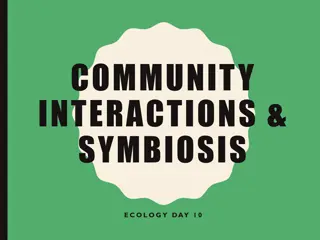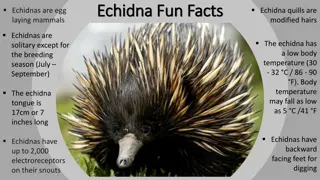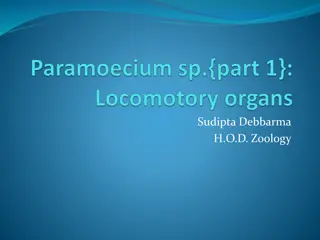Fascinating World of Lichens: Insights into a Unique Symbiotic Relationship
Lichens are intriguing dual organisms composed of algae and fungi, forming a symbiotic relationship with fascinating adaptations. They serve as environmental indicators, thriving in diverse habitats worldwide. Learn about their distribution, occurrence, composition, and general characteristics in this comprehensive overview provided by Associate Professor Dr. Prativa Deka.
Download Presentation

Please find below an Image/Link to download the presentation.
The content on the website is provided AS IS for your information and personal use only. It may not be sold, licensed, or shared on other websites without obtaining consent from the author. Download presentation by click this link. If you encounter any issues during the download, it is possible that the publisher has removed the file from their server.
E N D
Presentation Transcript
LICHENS PRATIVA DEKA ASSOCIATE PROFESSOR DEPT. OF BOTANY MANGALDAI COLLEGE
LICHEN: AN INTRODUCTION Lichens are dorsiventrally differentiated thallophytic plants. The word Lichen is derived from the Greek word Leprous which refers to medicine used for treatment of skin diseases because of their appearance as peeling skin. Although it appears a single plant, but actually it is a dual organism. It is very close association two organism i.e. Algae and Fungi. The fungal component of lichen ---Mycobiont The algal component of lichen --- Phycobiont Lichen is the symbiotic association of Algae and Fungi. Fungus protect algae from unfavourable conditions (drought) and algae supplies organic food to fungus.
DISTRIBUTION: World wide distribution, about 500 genera and 13500spp. Lichens do not grow near polluted areas. So Lichens are indicators of pollution. They can tolerate extreme heat and can bury in snow for long years.
OCCURRENCE OF LICHEN : Lichens occur commonly on tree barks, decaying logs, leaves, rocks, old walls and soils. On the basis of habitat they are classified into : Saxicolous: lichen growing on rocks Corticolous: lichen growing on tree barks Follicolous: lichen growing on leaves Terricolous: lichen growing on soil surface Few species of lichens are aquatic. e.g.Peltigera
CCOMPOSITION OF PLANT BODY: Mycobiont: Belong to either Ascomycetes or Basidiomycetes or Deuteromycetes Phycobiont: May belong to Cyanophyceae, Chlorophyceae, Xanthophyceae or Phaeophyceae COLOUR OF PLANT BODY: Lichens are highly pigmented and have various colours such as green, yellow, orange, bluish, reddish, white or black etc. Colouration is due to pigmentation of algal component.
GENERAL CHARACTERISTICS 1. Lichens are a group of plants of composite thalloid nature, formed by the association of algae and fungi. 2. In general, the major portion of the thallus is occupied by the fungal component. The fungal component produces its own reproductive structures. 3. The algal partner makes the food by the process of photosynthesis. The food diffuses out and is absorbed by the fungal partner. 4. The fungal partner serves the function of absorption and retention of water. 5. Owing to their symbiotic relationship, lichens can live in variety of habitats and climatic conditions including extreme environments.
GENERAL CHARACTERISTICS 6. The main plant body of the lichen is called as thallus. Thallus is the vegetative portion and is similar to the vegetative portions of mosses and liverworts. 7. Based on the morphological structure of thalli, they are of three types crustose, foliose and fruticose. 8. Lichen reproduces by all the three means vegetative, asexual, and sexual. 9. Vegetative reproduction takes place by fragmentation, decaying of older parts, by soredia and isidia. 10. Asexual reproduction takes place by the formation of oidia. 11. Sexual reproduction takes place by the formation of ascospores or basidiospores. Only fungal component is involved in sexual reproduction.
NATURE OF ASSOCIATION OF ALGAE AND FUNGI The nature of association of both the components of a lichen is quite controversial. Following three different explanations have been given for the nature of association (1) Mutualism or Symbiosis: According to some botanists the association in lichens is of symbiotic type because both the components i.e. alga and fungus are mutually benefited. The fungal component absorbs water and minerals from the substratum as well as absorbs moisture and provides protection to the algal partner. In return the fungal component derives food from the algal cells.
NATURE OF ASSOCIATION OF ALGAE AND FUNGI 2. Helotism: The fungal component in the lichen association is the dominating partner. The algal component lives as a prisoner or as a subordinate partner. Some workers have suggested the term helotism for such type of association. 3. Parasitism: Workers like Fink (1913) have suggested that the fungus lives as a parasite on the algal partner. As fungal hyphae give out haustoria and appresoria to absorb the food material from the algal cells. The algal partner is able to survive as an independent individual, if separated artificially from the fungal partner.
RANGE OF THALLUS MORPHOLOGY: Based on thallus morphology lichens are devided into four major groups 1. Crustose lichen 2. Foliose lichen 3. Fruticose lichen 4. Squamulose lichen
THALLUS MORPHOLOGY 1. Crustose lichen They have flattened thallus Thallus is flat, thin and like a thin layer Closely attached to the substratum as crust Difficult to separate them from substratum Example: Graphis, Strigula, Rhizocarpon
THALLUS MORPHOLOGY 2. Foliose lichen They are flat, dorsiventral, leaf like lobed structure They look like the thallus of liverworts Attached to the substratum by rhizoid like structures called rhizines Thallus is internally differentiated Example: Parmelia, Collema, Gyrophora
THALLUS MORPHOLOGY 3. Fruticose lichen Well developed shrub like, cylindrical and branched thallus They grow or hang from the substratum Plant attached to the substratum with the help of mucilagineous disk Thallus are hair like, finger like or twig like Example: Usnea, Cladonia
THALLUS MORPHOLOGY 4. Squamulose lichen Intermediate between foliose and crustose Scales, lobes smaller than in foliose Thallus is composed of small, overlapping scales called squamules They donot have lower cortex Example: Catapyrenium, Placidium
CLASSIFICATION OF LICHENS According to ICBN name of lichen should be on the basis of fungal component. No taxonomic significance is attached to algal partner. Previously lichens were not regarded as separate group and were distributed in fungi. Reinke (1896) for the first time regarded lichen as separate class. He classified lichens into three sub classes 1. Conicarpi (Ascocarp mazaedium) 2. Discocarpi (Ascocarp apothecium) 3. Pyrenocarpi (Ascocarp perithecium)
CLASSIFICATION OF LICHENS Alexopoulos and Mims (1979) devided lichens into three classes 1. Ascolichen: Fungal partner belongs to Ascomycetes, reproduction similar to Ascomycetes, produce Ascus and Ascospores. Sub-class: I. . Hymenoascolichen Hymenoascolichen - Ascus with one wall, arranged in hymenium Sub-class: II. . Loculoascolichen Loculoascolichen - Ascus with two walls, arranged in ascotroma 2. Basidiolichen:Fungal partner belongs to Basidiomycetes, produce Basidia and Basidiospores during reproduction 3. Deuterolichen: Fungal partner belongs to Deuteromycetes, lack sexual reproduction
INTERNAL STRUCTURE OF LICHEN THALLUS On the basis of internal structure of thallus, lichens are divided into two groups: 1. Homoiomerous lichen 2. Heteromerous lichen
INTERNAL STRUCTURE OF LICHEN THALLUS Structure of Homoiomerous lichen: The thallus Shows simple structure and little differentiation They donot exhibit layered structure Algal cells and fungal hyphae are equally distributed throughout the thallus e.g. Collema and Leptogium
INTERNAL STRUCTURE OF LICHEN THALLUS 2. Structure of Heteromerous Lichen Thallus: Most of the lichens belong to this category. They exhibit considerable differentiation and layered structure. The algal component in a heteromerous thallus is restricted to a specific zone or layer. Vertical section through the foliose thallus such as that of Parmelia or Xanthoria reveals the following four distinct zones: (a) Upper Cortex (b) Algal Zone (c) Medulla (d) Lower Cortex
INTERNAL STRUCTURE OF LICHEN THALLUS (a) Upper Cortex: (a) Upper Cortex: It forms the upper surface which is generally thick and protective. Generally it has an epidermis like configuration on the surface. Below this fungal hyphae grow more or less vertically and are compactly interwoven to produce a tissue-like layer (Plectenchyma or pseudoparenchyma) called the upper cortex. The fungal cells in the upper cortex are either closely packed without intercellular spaces between them or with intercellular spaces filled with gelatinous material.
INTERNAL STRUCTURE OF LICHEN THALLUS (b) Algal Zone: It is the blue-green or the green zone which lies immediately beneath the upper cortex. It consists of a network of loosely interwoven fungal hyphae with the algal cells. Common among the unicellular algae present in this layer are Chlorella, Pleurococcus and Cystococcus. Gloeocapsa. The filamentous blue-green algae found in the algal zone are Nostoc and Rivularia. The algal region is the photosynthetic region of the lichen thallus. Formerly it was called the gonidial layer. In some species, fungal hyphae send haustoria into the algal cells. The haustoria absorb nutrition for the fungus.
INTERNAL STRUCTURE OF LICHEN THALLUS (c) Medulla: It forms the central core of the thallus. It is less compact and consists of loosely interwoven hyphae with large spaces between them. The fungal hyphae in this region are scattered and usually have thick walls. They run in all directions. The central hyphae of the medullary region usually run longitudinally. They become very thick in the region of the vein and thin at the margin.
INTERNAL STRUCTURE OF LICHEN THALLUS (d) Lower Cortex: It forms the lower surface of the thallus and is composed of densely compacted hyphae. They may run perpendicular to the surface of the thallus or parallel to it. Bundles of hyphae (rhizinae) often arise from the surface of the lower cortex and penetrate the substratum to function as anchoring organs. In some lichen species the lower cortex is absent. Its place is taken up by a thin sheet of hyphae constituting the hypothallus. The rhizines in these species arise directly from the thicker part of the medullary region.
STRUCTURES ASSOCIATED WITH THE LICHEN STRUCTURES ASSOCIATED WITH THE LICHEN THALLUS THALLUS Associated with the lichen thallus there are certain other vegetative structures peculiar to lichens only. The most important or these are: 1. Breathing Pores 2. Cyphellae and Pseudocyphellae 3. Cephalodia 4. Isidia 5. Soredia
STRUCTURES ASSOCIATED WITH THE LICHEN THALLUS STRUCTURES ASSOCIATED WITH THE LICHEN THALLUS 1. Breathing Pores: In certain species of lichens particularly the foliose forms the compact nature of the upper cortex is interrupted at inervals. These areas are called breathing pores. Here the fungal hyphae are loosely interwoven. The tissue beneath the breathing pore is more of less medullary in nature. The breathing pores serve for aeration and may be in level with the surface or raised on cone-like elevations on the thallus.
STRUCTURES ASSOCIATED WITH THE LICHEN STRUCTURES ASSOCIATED WITH THE LICHEN THALLUS THALLUS 2. Cyphellae and Pseudocyphellae: Aerating organs in the form of organised breaks also occur in the lower cortex of a few foliose forms Under the microscope each spot is seen as a roundish cavity or a concave circular depression. Here the hyphae grow directly from the medulla and some rounded cells in a spore-like manner are attached at their tips. Such aerating pores may or may not have a definite border formed by the edge of the cortex. In the former case they are called the cyphellae and in the latter pseudocyphellae.
STRUCTURES ASSOCIATED WITH THE LICHEN STRUCTURES ASSOCIATED WITH THE LICHEN THALLUS THALLUS Lichens 3. Cephalodia : These are small, hard, dark- coloured, gall-like swellings on the free surface of some lichen thalli. The cephalodium contains the same fungal hyphae as in the thallus but the algal component is always different. Most cephalodia contain the blue green algae, so they can fix atmospheric nitrogen.
STRUCTURES ASSOCIATED WITH THE LICHEN STRUCTURES ASSOCIATED WITH THE LICHEN THALLUS 4. Isidia : THALLUS These are small outgrowths on the upper surface of the lichen thallus each consisting of an outer cortical layer followed by an algal layer of the same kind as in the thallus. The isidia vary in form in different lichen species. They may be rod- shaped, cigar- shaped, tiny coral-like buds and scale- shaped. The chief function of isidia appears to increase the photosynthetic surface of the lichen thallus. They also help in vegetative reproduction.
STRUCTURES ASSOCIATED WITH THE LICHEN STRUCTURES ASSOCIATED WITH THE LICHEN THALLUS THALLUS 5. Soredia: These are separable clumps of few algal cells closely envelop by fungal hyphae. They range from 25 micron -100 micron in diameter. They originate in medulla and algal layer. They come out through pores or cracks in the cortex.
REPRODUCTION OF LICHEN Lichen reproduces vegetatively, asexually and sexually Vegetative reproduction : Vegetative reproduction takes place by fragmentation and by the formation of special vegetative structure called soredia, isidia and lobules etc. Fragmentation can takes place by accidental breaking. The fragmented parts have both algae and fungi and develop into new thallus. The special vegetative structure soredia, isidia behave like buds and when they detached from the parent thallus, developed into new thallus.
REPRODUCTION OF LICHEN Asexual reproduction : Asexual reproduction takes place by formation of various types of asexual spores such as oidia, conidia by the fungal partner of ascolichen. These spores when dispersed from thallus germinate in favourable condition and form fungal hyphae in all direction. When these hyphae come in contact with algal partner grow further and imprisoned them. And ultimately they produced a new lichen thallus. Many lichens produce large number of small spore-like structures, pycniospores, within flask shaped pycnia, immersed within the thallus. These structures when act as male gametes are known as spermatia and spermagonia respectively.
REPRODUCTION OF LICHEN Sexual reproduction : Sexual reproduction of Mycobiont : In Ascolichens the sexual reproduction results in the formation of apothecia or perithecia. These fruiting bodies are small cup-like or disc-like and may be embedded in, or raised above the surface of thallus by short or long stalks. The male reproductive organ is called spermogonium and the female carpogonium or Ascogonium.
REPRODUCTION OF LICHEN Structure of Spermogonia: In some lichens pycnidia-like structures are reported to function as spermogonia. They are flask-shaped receptacle immersed in a small elevation on the upper surface of the thallus. They open by a small pore at the surface called ostiole. The cavity of the spermogonium is filled with the fertile and sterile hyphae. The fertile hyphae have rounded cells at their tips. These are the male cells called the spermatia. They are non-motile and set free through the ostiole.
REPRODUCTION OF LICHEN Carpogonium : The carpogonium is a special cellular filament. It consists of two portions, the lower coiled portion and the upper straight portion. The coiled portion is carpogonium or ascogonium. It is multicellular. The cells are uninucleate or multinucleate. The ascogonium lies deep in the medullary region. They either develop from the hyphae of the medullarly region or from the hyphae deep in the algal layer of the lichen thallus.
REPRODUCTION OF LICHEN Carpogonium : The straight upper portion is called the trichogyne. It is also multicellular. The cells are elongated. The terminal portion of the trichogyne projects beyond the surface of the thallus and has a gelatinous cell wall. One of the cells of the carpogonium generally middle one directly fuction as oogonium.
REPRODUCTION OF LICHEN Fertilization : At the time of reproductiontion a spermatium is lodged to the tip of the trichogyne. Then the walls of the spermatium and trichogyne dissolved at the point of contact. Then the contents of the spermatium pass into the trichogyne. There is much confusion about the actual migration of male nuclei and the act of fertilization. However, transference of the male nuclei in to the middle cell of the ascogonium leads to the formation of numerous ascogenous hyphae.
REPRODUCTION OF LICHEN Post fertilization changes : Fertilisation is followed by the following changes in the carpogonium After fertilization cells of trichgyne disintegrate. Numerous ascogenous hyphae developed from ascogonium. Asci are developed from the binucleate penultimate cells or ultimate cells of the ascogenous hyphae. The two nuclei fuse and form eigth ascospored ascus as usual manner. The asci are intermingled with long and sterile hyphae called paraphyses. Asci and paraphyses grow together along with surrounding vegetative hyphae and form a fruiting body or ascocarp.
REPRODUCTION OF LICHEN The fruiting body may be Apothecium or Perithecium type. Perithecia are typcally flask-like; apothecia are variable in shape but commonly disc- or saucer-shaped. Perithecia Apothecia
REPRODUCTION OF LICHEN The development of asci and ascospores resembles to that of typical Ascomycetes. When ascospores are liberated from ascus they germinate and producing hyphae. They grows in all directions and as soon as it comes in contact with a suitable alga, additional branches are formed to engulf the alga. Combined growth of the fungus and the alga continues and results in a lichen. In absence of a suitable alga the germ tube dies.
REPRODUCTION OF LICHEN Fig: (A) V.S. of lichen Fig: (A) V.S. of lichen thallus thallus through through Apothecium Apothecium. (B) . (B) Aportion Aportion of of Hymenium Hymenium
REPRODUCTION OF LICHEN Reproduction of Basidiolichens : Basidiolichens reproduce by basidiospores produced on basidia as in typical Basidiomycetes. Lower surface of the thallus bears subhymenium, and basidia are arranged palisade-like on the lowermost face of each subhymenium. Each basidium bears four basidiospores at the tips of sterigmata.
REPRODUCTION OF LICHEN Reproduction of Phycobiont : The green algal component of the lichen thallus multiplies by cell division. Ahmadjean (1967) reported the formation of aplanospores. Slocum et al. (1980) observed zoospores in the thallus of Parmelia. The blue-green algal components in the algal thallus have been reported to multiply by cell division, hormogonia, akinetes and heterocysts.
THANKS THANKS


